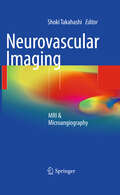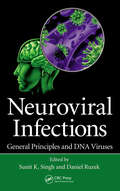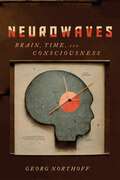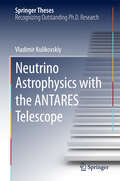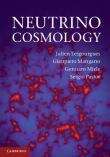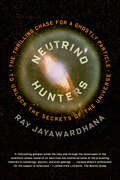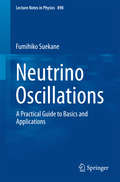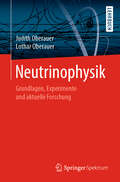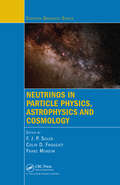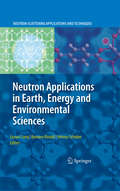- Table View
- List View
Neurotropic Viral Infections
by Carol Shoshkes ReissThis second edition is a comprehensive study of the viruses that affect the brain and the central nervous system. Along with a focus on the viruses themselves, it addresses the diseases they cause, current treatments and preventive measures. Also discussed are the unique aspects of how viruses cause disease and why certain hosts are more susceptible (e. g. , polymorphisms, age, co-morbidities). Because there are 29 cutting edge chapters, written by experts in the fields, Neurotropic Viral Infections has been divided into two separate volumes. Volume 1, Neurotropic RNA Viruses, includes 14 chapters on RNA viruses that cause human disease of the central nervous system ranging from Bornavirus to polio to West Nile. Volume 2, Neurotropic Retroviruses, DNA Viruses, Immunity and Transmission, includes 15 chapters divided into two parts. Part 1 includes 7 chapters on retroviruses and DNA viruses that cause human disease of the central nervous system ranging from HIV to varicella zoster virus. Part 2 includes chapters on transmission of these viruses by transplantation, bites by bats and insects, clinical management of the infections, and beneficial uses of attenuated viruses. Neurotropic Viral Infections is a unique resource, bridging basic, clinical, and translational approaches.
Neurovascular Imaging
by Shoki TakahashiThe comparison of MR images and cadaver microangiograms of the basal perforating arteries is crucial for understanding the courses and supply areas of these vessels and in turn, for diagnosing pathologies in this region. Divided into three sections- normal anatomy of brain vessels; neurovascular imaging in pathology; and anatomy and imaging of spinal vessels- Neurovascular Imaging contains a rich collection of images to teach the reader how to interpret MR images of the brain vessels and spinal vessels, and how to identify pathological signs. Written and edited by a group of highly acclaimed experts in the field, Neurovascular Imaging is an authoritative account of the interpretation of MR images of the brain vessels and spinal vessels, and is a valuable addition to the library of the diagnostic radiologist.
Neurovascular Neuropsychology
by Joanne Festa Ronald Lazar J. P. MohrNeurovascular diseases and conditions, and their associated risk factors, represent a significant cause of cognitive disability in the United States and throughout the world. In the USA alone there are 750,000 new strokes each year, representing the number one cause of disability in the country. Hypertension, found in approximately 50 million Americans, has been shown to be associated with alterations of cognitive function, even in the absence of stroke and dementia. Recent studies of neurovascular disease have now revealed that neuropsychological function may be a more sensitive measure of brain integrity than coordination, motor or sensory function and correlates will with functional outcome measures. Neurovascular Neuropsychology focuses on focal and diffuse neurovascular disease in addition to systemic conditions in which cognition and behavior have been uniquely associated with different pathologic states. With an increasing number of patients being treated by healthcare professionals, Neurovascular Neuropsychology will prove to be a strong reference to consult in regards to neuropsychological syndromes.
Neurovascular Neuropsychology
by Ronald M. Lazar MaryKay A. Pavol Jeffrey N. BrowndykeThis book covers the explosion of new information about the relationship between the brain and its blood supply since the first edition was published in 2009. With new knowledge and its impact on clinical care, neurovascular neuropsychology has become a recognized sub-specialty that has been integrated into health care systems in the US and abroad. The second edition brings to this larger audience the latest word on these matters, with new emphasis on women’s issues, relevance to the pediatric population, insights from modern imaging, and advances in medical and surgical treatments such as heart transplantation, cardiovascular transarterial therapies, and noninvasive brain stimulation in connection with neurocognitive outcomes.
Neuroviral Infections: General Principles and DNA Viruses
by Sunit K. Singh Daniel RůžekNeurovirology is an interdisciplinary field representing a melding of virology, clinical neuroscience, molecular pathogenesis, diagnostic virology, molecular biology, and immunology. Neuroviral Infections: General Principles and DNA Viruses covers recent developments in the area of neuroviral infections and discusses their role in related fields su
Neurowaves: Brain, Time, and Consciousness
by Georg NorthoffThe connection of the brain to the mind remains one of the most persistent mysteries in philosophy and neuroscience. Georg Northoff proposes a new approach to the so-called mind-body problem, drawing on an insight from physics: time structures all objects and events in the world, and all objects and events are in dynamic relationship. This also shapes the brain as it is part of the dynamic of the world as whole.In Neurowaves Northoff posits that the entire world is structured by waves of time and argues that the passing of these waves through our brains – neurowaves – produces mental experience. The brain’s neural waves transform into mental waves; time and its dynamics are shared by brain and mind as their common currency. As in physics and biology, that radically changes our view. Copernicus showed how the earth moves and that its movements are just a tiny part of the universe’s passage of time. Darwin showed that the human species is one among many species passing through evolution’s timescales. Northoff calls for another Copernican revolution, replacing the mind-body problem with questions about the temporal-dynamic relationship between brain and world.Illustrated with vivid examples from different facets of the physical and biological world, Neurowaves provides captivating insights and an innovative, entertaining unravelling of the temporal connection of brain and mind.
Neurowissenschaften des Stresses: Von der Neurobiologie zu den Kognitions-, Emotions- und Verhaltenswissenschaften
by Gustavo E. TafetDieses Lehrbuch bietet eine Einführung in das interdisziplinäre Studium von Stress und hilft Studierenden und Fachleuten, die wichtigsten neurobiologischen und psychologischen Ursachen und Folgen von Stress beim Menschen zu verstehen. Es zielt darauf ab, das Konzept von Stress auf verschiedenen Ebenen zu verstehen, von den Auswirkungen von Umweltstressoren bis zu seiner Verarbeitung im Gehirn und von den neuronalen Mechanismen, die an dieser Verarbeitung beteiligt sind, bis zum Ausdruck verschiedener adaptiver Reaktionen. Alle diese neuronalen Mechanismen werden auf verschiedenen Komplexitätsebenen klar erläutert, von der neurobiologischen Ebene, einschließlich der zellulären und molekularen Mechanismen, bis zur psychologischen Ebene, einschließlich der kognitiven und emotionalen Verarbeitung und der Verhaltensäußerungen.Der Inhalt ist fundiert und wird von anschaulichen Grafiken begleitet, die Details sehr hilfreich verdeutlichen und somit eine vollständige Integration aller dargestellten Konzepte ermöglichen. Darüber hinaus werden klinische Ausdrucksformen von Stress, wie z.B. Stimmungs- und Angststörungen, ausführlich behandelt. Auch erhalten Sie einen Überblicks über verschiedene Faktoren der Anfälligkeit und Widerstandsfähigkeit, wodurch ein einzigartiger und grundlegender Einblick in dieses interdisziplinäre Gebiet geboten wird. Aufgrund seines interdisziplinären Ansatzes bietet Neuroscience of Stress: From Neurobiology to Cognitive, Emotional and Behavioral Sciences (Von der Neurobiologie zu den Kognitions-, Emotions- und Verhaltenswissenschaften) Studierenden und Fachleuten aus verschiedenen Bereichen der Verhaltens- und Gesundheitswissenschaften eine umfassende und klare Einführung in die Erforschung von Stress und ist bestens geeignet für den Einsatz in einer Vielzahl von Studiengängen, die sich mit psychischer Gesundheit und Wohlbefinden befassen, u. a. in den Bereichen Gesundheit und klinische Psychologie, Gesundheitsförderung undKrankheitsprävention, Psychiatrie und Verhaltensmedizin.
Neurowissenschaften: Ein Grundlegendes Lehrbuch Für Biologie, Medizin Und Psychologie
by Mark F. Bear Michael A. Paradiso Monika Niehaus-Osterloh Barry W. Connors Andreas K. Engel Andreas HeldDer perfekte Einstieg in die Neurowissenschaften – ideal zum Verstehen und LernenSeit vielen Jahren zählt diese didaktisch durchdachte, verständlich geschriebene und hervorragend illustrierte Einführung international zu den führenden Lehrbüchern im Bereich der Neurowissenschaften. Das moderne Grundlagenwerk richtet sich an Studierende der Biologie, der Medizin und der Psychologie gleichermaßen. Die wieder von Andreas Engel herausgegebene deutsche Ausgabe ist an die hiesige Studiensituation angepasst und stellenweise erweitert. Der Bogen spannt sich von der Anatomie des Gehirns bis zur Sinnesphysiologie, von der Entwicklungsbiologie bis zum Verhalten, von den Störungen des Nervensystems bis zur Kognitionswissenschaft, von den molekularen Mechanismen bis zu den neuen bildgebenden Verfahren. Ein eigenständiger „Bildatlas der menschlichen Neuroanatomie“ erlaubt dem Lernenden, seine Kenntnisse der Hirnstrukturen zu überprüfen und zu erweitern. Jedes Kapitel endet mit Verständnisfragen und Übungsaufgaben sowie einer Zusammenstellung wichtiger weiterführender Literatur. In spannenden Exkursen berichten renommierte Wissenschaftler, wie sie zu ihren entscheidenden Entdeckungen kamen. So führt das Buch den Leser von den Grundlagen zu den aktuellen Forschungsthemen des Faches.In der durchgehend aktualisierten 4. Auflage sind unter anderem neue Forschungsergebnisse zu Optogenetik, Konnektomik, tiefer Hirnstimulation, molekularer Medizin und Neuroökonomie eingearbeitet worden. Zahlreiche neue oder aktualisierte Abbildungen veranschaulichen in bewährter Manier die im Text beschriebenen Prozesse, Strukturen und Methoden. Wer Neurowissenschaften in ihrer ganzen Bandbreite verstehen will, ist mit "dem Bear" bestens bedient. Den drei Verfassern des Buches gelingt, womit Lehrbuchautoren im deutschsprachigen Raum sich nach wie vor schwer tun: anschaulich und spannend den Leser vom Einstieg in die Grundlagen bis an die vorderste Front der Forschung mitzunehmen und ohne überflüssigen Ballast wissenschaftliche Erkenntnis mehr erzählend als erklärend zu vermitteln … Ein didaktisches Meisterwerk ist nun topaktuell auch in deutscher Sprache neu aufgelegt verfügbar. Aus dem Vorwort von Prof. Andreas K. Engel, Universitätsklinikum Hamburg-Eppendorf
Neustart des LHC: Die Teilchenphysik hinter der Weltmaschine anschaulich erklärt (essentials)
by Alexander KnochelDieses Essential gibt eine kompakte Einführung in unser aktuelles Bild der Elementarteilchenphysik. Es legt dabei den Schwerpunkt auf Phänomene wie das Higgs-Teilchen, welche am Large Hadron Collider (LHC) erforscht werden. Der LHC am Forschungszentrum CERN bei Genf ist der leistungsfähigste Beschleuniger der Welt und läuft seit dem Frühjahr 2015 erneut mit Rekordenergie. Der Autor beschreibt, wie das sogenannte ,,Standardmodell der Teilchenphysik" aufgebaut ist und wie die Experimente des LHC es durch genauere Messungen festigen und durch neue Entdeckungen revolutionieren können. Dabei werden die wichtigsten grundlegenden Begriffe erklärt: Was sind beispielsweise virtuelle Teilchen, und welche Rolle spielen sie in der Natur? Was ist eine Quantenfeldtheorie? Sind die Elementarteilchen wirklich elementar? Was ist Symmetriebrechung?
Neustart des LHC: Die Teilchenphysik hinter der Weltmaschine anschaulich erklärt (essentials)
by Alexander KnochelIn diesem essential gibt Alexander Knochel einen #65533;berblick #65533;ber aktuelle Probleme und offene Fragen der Teilchenphysik und Kosmologie und erl#65533;utert, wie der Large Hadron Collider zu ihrer Kl#65533;rung beitragen kann. Dazu nimmt der Autor den Leser mit auf einen Streifzug durch neue physikalische Ph#65533;nomene, die Grenzen unserer bisherigen Theorien und theoretische #65533;berlegungen, was uns bei diesen bisher im Labor unerreichten Energieskalen erwarten k#65533;nnte. Es wird spannend, denn der leistungsf#65533;higste Teilchenbeschleuniger der Welt, der Large Hadron Collider, l#65533;uft wieder mit Rekordenergie!
Neustart des LHC: Die Weltmaschine anschaulich erklärt (essentials)
by Michael HauschildMichael Hauschild führt den Leser dieses essentials zurück zu den Anfängen des CERN, des Europäischen Forschungszentrums für Teilchenphysik bei Genf; einem der faszinierendsten Forschungszentren überhaupt, zu seiner Geschichte, zu seinen Menschen und seinen Beschleunigern. Der Autor erläutert die Funktionsweise von Teilchenbeschleunigern und wie ausgehend von den ersten Ideen schließlich der Large Hadron Collider LHC gebaut wurde, der größte Teilchenbeschleuniger der Welt und die heutige Weltmaschine. Nach einer Pause von mehr als zwei Jahren wurde der LHC im Frühjahr 2015 wieder in Betrieb genommen, um mit höherer Energie als je zuvor die Geheimnisse der Natur zu enträtseln.
Neustart des LHC: Die Weltmaschine anschaulich erklärt (essentials)
by Michael HauschildMichael Hauschild führt den Leser zurück ins Jahr 2012, als am CERN, dem Europäischen Forschungszentrum für Teilchenphysik bei Genf – einem der faszinierendsten Forschungszentren überhaupt – die Entdeckung des Higgs-Teilchens nach einer langen Jagd am Large Hadron Collider LHC verkündet wurde. Der Autor erläutert anschaulich den Higgs-Mechanismus zur Erzeugung von Masse mit der zentralen Rolle des Higgs-Teilchens in der aktuellen Teilchenphysik. Nach einer Pause von mehr als zwei Jahren wurde der LHC, der größte Teilchenbeschleuniger der Welt und die heutige Weltmaschine, im Frühjahr 2015 wieder in Betrieb genommen, um mit höherer Energie als je zuvor die Geheimnisse der Natur zu enträtseln. Ein Überblick über zukünftige Projekte bildet den Abschluss dieses essentials.Der Autor Dr. Michael Hauschild ist Teilchenphysiker am CERN in Genf und seit 2005 Mitglied des ATLAS Experiments am Large Hadron Collider LHC. Während der ersten langen Messperiode des LHC von 2010 bis 2012 hat er die Entdeckung des Higgs-Teilchens im Sommer 2012 unmittelbar miterlebt.
Neustart des LHC: Die Weltmaschine anschaulich erklärt (essentials)
by Michael HauschildMichael Hauschild führt den Leser dieses essentials zurück in den September 2008 zum holprigen Start des Large Hadron Collider LHC, des größten Teilchenbeschleunigers der Welt und der heutigen Weltmaschine am CERN, dem Europäischen Forschungszentrum für Teilchenphysik bei Genf – einem der faszinierendsten Forschungszentren überhaupt. Der Autor erläutert, wie ausgehend von den ersten Ideen die großen Kollaborationen am LHC entstanden, Zusammenschlüsse von bis zu 3.000 Physikern. Die Kollaborationen sind es, die mit Hilfe von riesigen Teilchendetektoren die Kollisionen am LHC vermessen und dabei auf die Entdeckung von neuen Teilchen hoffen. Nach einer Pause von mehr als zwei Jahren wurde der LHC im Frühjahr 2015 wieder in Betrieb genommen, um mit höherer Energie als je zuvor die Geheimnisse der Natur zu enträtseln.Der Autor Dr. Michael Hauschild ist Teilchenphysiker am CERN in Genf und seit 2005 Mitglied des ATLAS Experiments am Large Hadron Collider LHC. Während der ersten langen Messperiode des LHC von 2010 bis 2012 hat er die Entdeckung des Higgs-Teilchens im Sommer 2012 unmittelbar miterlebt.
Neutrino Astrophysics with the ANTARES Telescope
by Vladimir KulikovskiyThis thesis is devoted to ANTARES, the first underwater neutrino telescope in the Mediterranean sea. As the main scientific analysis, a search for high-energy neutrino emission from the region of the Fermi bubbles has been performed using data from the ANTARES detector. A method for the background estimation using off-zones has been developed specially for this measurement. A new likelihood for the limits calculation which treats both observations in the on-zone and in the off-zone in the similar way and also includes different systematic uncertainties has been constructed. The analysis of 2008-2011 ANTARES data yielded a 1. 2 σ excess of events in the Fermi bubble regions, compatible with the no-signal hypothesis. For the optimistic case of no energy cutoff in the flux, the upper limit is within a factor of three of the prediction of the purely hadronic model based on the measured gamma-ray flux. The sensitivity improves as more data are accumulated (more than 65% gain in the sensitivity is expected once 2012-2016 data are added to the analysis).
Neutrino Cosmology
by Julien Lesgourgues Gianpiero Mangano Gennaro Miele Sergio PastorThe role that neutrinos have played in the evolution of the Universe is the focus of one of the most fascinating research areas that has stemmed from the interplay between cosmology, astrophysics and particle physics. In this self-contained book, the authors bring together all aspects of the role of neutrinos in cosmology, spanning from leptogenesis to primordial nucleosynthesis, their role in CMB and structure formation, to the problem of their direct detection. The book starts by guiding the reader through aspects of fundamental neutrino physics, such as the standard cosmological model and the statistical mechanics in the expanding Universe, before discussing the history of neutrinos in chronological order from the very early stages until today. This timely book will interest graduate students and researchers in astrophysics, cosmology and particle physics, who work with either a theoretical or experimental focus.
Neutrino Hunters: The Thrilling Chase for a Ghostly Particle to Unlock the Secrets of the Universe
by Ray JayawardhanaWinner of the Canadian Science Writers Association Science in Society Book AwardOne of the Best Physics Books of 2013, Cocktail Party Physics Blog, Scientific AmericanDetective thriller meets astrophysics in this adventure into neutrinos and the scientists who pursue themThe incredibly small bits of matter we call neutrinos may hold the secret to why antimatter is so rare, how mighty stars explode as supernovae, what the universe was like just seconds after the big bang, and even the inner workings of our own planet.For more than eighty years, adventurous minds from around the world have been chasing these ghostly particles, trillions of which pass through our bodies every second. Extremely elusive and difficult to pin down, neutrinos are not unlike the brilliant and eccentric scientists who doggedly pursue them.In Neutrino Hunters, the renowned astrophysicist and award-winning writer Ray Jayawardhana takes us on a thrilling journey into the shadowy world of neutrinos and the colorful lives of those who seek them. Demystifying particle science along the way, Jayawardhana tells a detective story with cosmic implications—interweaving tales of the sharp-witted theorist Wolfgang Pauli; the troubled genius Ettore Majorana; the harbinger of the atomic age Enrico Fermi; the notorious Cold War defector Bruno Pontecorvo; and the dynamic dream team of Marie and Pierre Curie. Then there are the scientists of today who have caught the neutrino bug, and whose experimental investigations stretch from a working nickel mine in Ontario to a long tunnel through a mountain in central Italy, from a nuclear waste site in New Mexico to a bay on the South China Sea, and from Olympic-size pools deep underground to a gigantic cube of Antarctic ice—called, naturally, IceCube.As Jayawardhana recounts a captivating saga of scientific discovery and celebrates a glorious human quest, he reveals why the next decade of neutrino hunting will redefine how we think about physics, cosmology, and our lives on Earth.
Neutrino Oscillations
by Fumihiko SuekaneNeutrino oscillation (N. O. ) is the only firm evidence of the physics beyond the Standard Model of particle physics and is one of the hottest topics in elementary particle physics today. This book focuses on the N. O. , from its history to the future prospects, from the basic theories to the experiments. Various phenomena of N. O. are described intuitively with thorough explanations of the fundamental physics behind well-known formulations. For example, while many textbooks start with a discussion of the mixing matrix, this book stresses that N. O. is caused by the transition amplitudes between different neutrino flavors, and that the purpose of N. O. experiments is to measure transition amplitudes and think of its origin. The current understanding of neutrino oscillation is also summarized using the most up-to-date measurements, including the recently measured neutrino mixing angle θ13, and the future prospects of N. O. studies are described as well. The level of this book makes it a bridge between introductory textbooks and scientific papers.
Neutrino Physics (Series in Particle Physics, Cosmology and Gravitation)
by Kai ZuberWhen Kai Zuber’s pioneering text on neutrinos was published in 2003, the author correctly predicted that the field would see tremendous growth in the immediate future. In that book, Professor Zuber provided a comprehensive self-contained examination of neutrinos, covering their research history and theory, as well as their application to particle physics, astrophysics, nuclear physics, and the broad reach of cosmology; but now to be truly comprehensive and accurate, the field’s seminal reference needs to be revised and expanded to include the latest research, conclusions, and implications. Revised as needed to be equal to the research of today, Neutrino Physics, Third Edition delves into neutrino cross-sections, mass measurements, double beta decay, solar neutrinos, neutrinos from supernovae, and high-energy neutrinos, as well as entirely new experimental results in the context of theoretical models. Written to be accessible to graduate students and readers from diverse backgrounds, this edition, like the first, provides both an introduction to the field as well as the information needed by those looking to make their own contributions to it. And like the second edition, it whets the researcher’s appetite, going beyond certainty to pose those questions that still need answers. Features Presents the only single-author comprehensive text on neutrino physics Includes experimental and theoretical particle physics and examines solar neutrinos and astroparticle implications Offers details on new developments and recent experiments
Neutrino Physics in Present and Future Kamioka Water‐Čerenkov Detectors with Neutron Tagging (Springer Theses)
by Pablo Fernández MenéndezThis book discusses the upgrade of the Super-Kamiokande (SK) detector, which consists in the addition of a salt of gadolinium into the detector’s water, the goal being to endow it with a very high-efficiency ability to detect neutrons: the SuperK-Gd project. This will substantially improve the scientific value of the SK detector because, among others, neutron production is related to the matter–antimatter character of the interacting neutrino. In this book the authors develop several procedures for maximizing the impact of neutron tagging in various physics analyses involving a broad range of neutrino energy. They thoroughly study the impact of new backgrounds introduced by Gd in key physics analyses, most remarkably including the search for the Diffuse Supernova Neutrino Background. At GeV energies, the neutron tagging improvements are evaluated by performing a complete neutrino oscillation sensitivity study using atmospheric and long baseline neutrinos, with a focus on the neutrino mass hierarchy and the leptonic CP violation. In order to prove the relevance of neutron tagging with the available data, the authors apply the neutron-tagging tools developed here to the 4th phase of the SK detector, which is already capable of detecting a low fraction of the neutrons produced through hydrogen-neutron captures. A global oscillation analysis of the SK’s atmospheric neutrino data is also conducted.
Neutrinophysik: Grundlagen, Experimente und aktuelle Forschung
by Lothar Oberauer Judith OberauerDas vorliegende Buch bietet dem Leser einen Überblick über die Physik der Neutrinos, der leichtesten Fermionen im Standardmodell der Teilchenphysik. Neben den Grundlagen und der theoretischen Beschreibung beleuchten die Autoren aktuelle Forschung und offene Fragestellungen zur Neutrinophysik. Die Autoren besprechen die Rolle dieser Teilchen in Kosmologie und Astrophysik, gehen auf moderne Neutrino-Experimente ein und erklären die aktuellsten Ergebnisse verständlich. Grundlagen zum Verständnis des Buches sind Kenntnisse der klassischen Physik und Grundkenntnisse der Quantenmechanik - Vorkenntnisse in der Kern- und Teilchenphysik schaden nicht, sind aber auch nicht unbedingt nötig. Das Buch richtet sich an Bacheloranden, Master-Studierende, Doktorandinnen und Doktoranden und Postdocs, die im Bereich der theoretischen oder experimentellen Neutrinophysik ihre Abschlussarbeit schreiben und forschen. Aus dem Inhalt: Neutrinos im Standardmodell Neutrinooszillationen Experimente zu Neutrinooszillationen Status von Neutrinooszillationen und offene Fragen Neutrinos in Astrophysik und Kosmologie
Neutrinos in High Energy and Astroparticle Physics
by José Wagner Valle Jorge RomaoThis self-contained modern textbook provides a modern description of the Standard Model and its main extensions from the perspective of neutrino physics. In particular it includes a thorough discussion of the varieties of seesaw mechanism, with or without supersymmetry. It also discusses schemes where neutrino mass arises from lighter messengers, which might lie within reach of the world's largest particle accelerator, the Large Hadron Collider. Throughout the text, the book stresses the role of neutrinos due to the fact that neutrino properties may serve as a guide to the correct model of unification, hence for a deeper understanding of high energy physics, and because neutrinos play an important role in astroparticle physics and cosmology. Each chapter includes summaries and set of problems, as well as further reading.
Neutrinos in Particle Physics, Astrophysics and Cosmology
by F. J. P. Soler Colin D. Froggatt Franz MuheimUp to date and comprehensive in its coverage, Neutrinos in Particle Physics, Astrophysics and Cosmology reviews the whole landscape of neutrino physics, from state-of-the-art experiments to the latest phenomenological and theoretical developments to future advances.With contributions from internationally recognized leaders in the field, the book co
Neutrinos, Dark Matter and Co.: From the Discovery of Cosmic Radiation to the Latest Results in Astroparticle Physics
by Claus GrupenIn this essential, Claus Grupen discusses astroparticle physics in a short historical outline and describes the latest results without going into mathematical detail. As an introduction to this new field of research, he gives an overview of what happens in the sky, between stars and between galaxies. By now, many things are quite well understood, but with every solution found, new questions arise - the author also deals with this spectrum of questions with some answers. Today, astroparticle physics is an active, interdisciplinary field of research that includes and combines astronomy, cosmic rays and elementary particle physics.This Springer essential is a translation of the original German 1st edition essentials, Neutrinos, Dunkle Materie und Co. by Claus Grupen, published by Springer Fachmedien Wiesbaden GmbH, part of Springer Nature in 2021.The translation was done with the help of artificial intelligence (machine translation by the service DeepL.com). A subsequent human revision was done primarily in terms of content, so that the book will read stylistically differently from a conventional translation. Springer Nature works continuously to further the development of tools for the production of books and on the related technologies to support the authors
Neutrinos, Dunkle Materie und Co.: Von der Entdeckung der kosmischen Strahlung zu den neuesten Ergebnissen der Astroteilchenphysik (essentials)
by Claus GrupenClaus Grupen erörtert in diesem essential in einem kurzen historischen Abriss die Astroteilchenphysik und beschreibt die neuesten Resultate, ohne ins mathematische Detail zu gehen. Als Einstieg in dieses neue Forschungsgebiet verstanden, gibt er einen Überblick darüber, was sich am Himmel, zwischen den Sternen und zwischen den Galaxien abspielt. Es ist inzwischen schon vieles recht gut verstanden, aber mit jeder gefundenen Lösung tun sich auch neue Fragen auf – auf dieses Fragenspektrum mit einigen Antworten geht der Autor ebenfalls ein. Heute ist die Astroteilchenphysik ein aktives, interdisziplinäres Forschungsgebiet, das Astronomie, kosmische Strahlung und Elementarteilchenphysik umfasst und vereinigt.
Neutron Applications in Earth, Energy and Environmental Sciences
by Romano Rinaldi Liyuan Liang Helmut SchoberNeutron Applications in Earth, Energy and Environmental Sciences offers a comprehensive overview of the wide ranging applications of neutron scattering techniques to elucidate the fundamental materials properties at the nano-, micro- and meso-scale, which underpin research in the related fields of Earth, Energy and Environmental Sciences. Introductions to neutron scattering fundamentals and instrumentation are paired with a thorough review of the applications to a large variety of scientific and technological problems, written through the direct experience of leading scientists in each field. Tailored to a wide audience, this volume provides the novice with an inspiring introduction and stimulates the expert to consider these non-conventional problem solving techniques in his/her field of interest. Earth and environmental scientists, engineers, researchers and graduate students involved with materials science will find Neutron Applications in Earth, Energy and Environmental Sciences a valuable ready-to-use reference.

